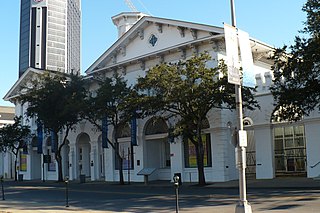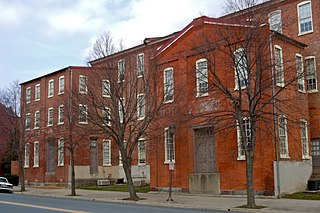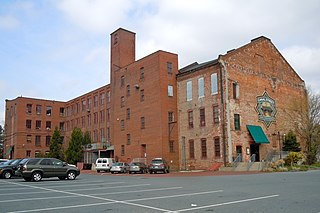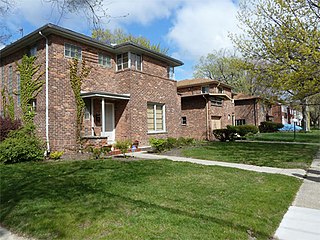
Glencairn is a castle-like mansion in Bryn Athyn, Pennsylvania, that was home to the Pitcairn family for more than 40 years. Now the Glencairn Museum, it contains a collection of about 8,000 artworks, mostly religious in nature, from cultures such as ancient Egypt, ancient Greece, the Roman Empire and medieval Europe, as well as Islamic, Asian, and Native American works. The museum is affiliated with The New Church, and the building is on the National Register of Historic Places.

The Fisher Fine Arts Library was the primary library of the University of Pennsylvania from 1891 to 1962. The red sandstone, brick-and-terra-cotta Venetian Gothic giant—part fortress and part cathedral—was designed by the acclaimed Philadelphia architect Frank Furness (1839–1912).

Old City Hall, also known as the Southern Market, is a historic complex of adjoining buildings in Mobile, Alabama, that currently houses the History Museum of Mobile. The complex was built from 1855 to 1857 to serve as a city hall and as a marketplace. It was declared a National Historic Landmark in 1973, as a rare well-preserved example of a 19th-century multifunction civic and commercial building.

The Pearl Street School is a historic school building at 75 Pearl Street in Reading, Massachusetts. Built in 1939, the two-story brick and limestone building is Reading's only structure built as part of a Public Works Administration project. The site on which it was built was acquired by the town sometime before 1848, and served as its poor farm. With fifteen classrooms, the school replaced three smaller wood-frame schoolhouses in the town's school system, and was its first fire-resistant structure.

George Washington's Gristmill was part of the original Mount Vernon plantation, constructed during the lifetime of the United States' first president. The original structure was destroyed about 1850. The Commonwealth of Virginia and the Mount Vernon Ladies’ Association have reconstructed the gristmill and the adjacent distillery. The reconstructed buildings are located at their original site three miles (4.8 km) west of the Mount Vernon mansion near Woodlawn Plantation in the Mont Vernon area of Fairfax County. Because the reconstructed buildings embody the distinctive characteristics of late eighteenth century methods of production and are of importance to the history of Virginia, the site is listed on the National Register of Historic Places despite the fact that the buildings are not original.

The Revloc Historic District is a national historic district located at Cambria Township in Cambria County, Pennsylvania.

Dickson Works, also known as the Stacor Building, is a historic factory building located at 225 Vine Street in Scranton, Pennsylvania, a town in Lackawanna County. It was built about 1856, and is a long three-story, brick industrial building measuring 100 feet by 300 feet. It features a tower measuring 100 feet tall, a double pitched roof with clerestory windows, and shallow segmental arched windows. It once housed the Dickson Works, a shop to repair and manufacture mine machinery and boilers. The Stacor Equipment Company occupied the building in 1963, and manufactured library tables and furniture.

Chester Waterside Station of the Philadelphia Electric Company is a historic former coal-fired power station, located on the Delaware River in Chester, Delaware County, southeastern Pennsylvania.

The Guy C. Irvine House, also known as "The Locusts," The Walker House, and The Kopf House, is an historic home which is located outside of Pine Grove Township, Warren County, Russell, Pennsylvania.

The Clinton–Hardy House on S. Guthrie in Tulsa, Oklahoma was built in 1919. It was designed by architect George Winkler and built for Mr. and Mrs. Lee Clinton. It was listed on the National Register of Historic Places in 1979.

The Hendel Brothers, Sons and Company Hat Factory, also known as "The Hat Factory," is an historic factory building which is located in Reading, Berks County, Pennsylvania.

The Reading Knitting Mills is an historic, American factory building that is located in Reading, Berks County, Pennsylvania.

The Reading Hardware Company, also known as "The Hardware," is an historic, American factory complex and national historic district that is located in Reading, Berks County, Pennsylvania.

The Log House, Hiester House, and Market Annex is an historic, American building that is located in Reading, Berks County, Pennsylvania.

The Newtown Historic District is a national historic district that is located in Newtown, Bucks County, Pennsylvania. It includes 293 contributing buildings in the borough of Newtown, which date from the late-17th century to the early-20th century and are reflective of a number of popular architectural styles including Greek Revival, Late Victorian, Federal, Queen Anne, and Gothic Revival. Notable buildings include the Chapman Buckman House and mill, Hart House, Newtown Hardware House, Keller Building, Jenks House (1828), White Hall Hotel, Temperance House (1774), Smock House (1792), the Brick Hotel, St. Luke's Church, LaRue Apartments (1838), and the Edward Hicks House. Located in the district and listed separately are the Half-Moon Inn and Friends Meeting House. It was added to the National Register of Historic Places in 1979, with two boundary increases in 1986.

The William and Margot Kessler House is a private house located at 1013 Cadieux Road in Grosse Pointe Park, Michigan. It was listed on the National Register of Historic Places in 2013.

The Cocheco Mills comprise a historic mill complex in the heart of Dover, New Hampshire. The mills occupy a bend in the Cochecho River that has been site of cotton textile manufacturing since at least 1823, when the Dover Manufacturing Company supplanted earlier sawmills and gristmills. The present mill buildings were built between the 1880s and the early 20th century, and were listed on the National Register of Historic Places in 2014.

The Louis G. Redstone Residential Historic District consists of three houses located at 19303, 19309 and 19315 Appoline Street in the Greenwich Park neighborhood in northwest Detroit. It was listed on the National Register of Historic Places in 2014.

The Barela–Bledsoe House is a historic house in the North Valley of Albuquerque, New Mexico. It was built around 1870 by Juan Estevan Barela (1842–1886), a prosperous farmer and merchant. At the time of his death, he owned over 100 acres (0.40 km2) of land and 13,000 sheep. The house was inherited by his widow Abundia García de Barela, who owned the property until her death. In the twentieth century, it was the residence of Robert Dietz III, whose previous home is also a listed historic property. The Barela–Bledsoe House was listed on the New Mexico State Register of Cultural Properties in 1976 and the National Register of Historic Places in 1979.

Villa Maria is a retirement community located at 1315 Walker NW in Grand Rapids, Michigan. The campus was originally operated for the purpose of ministering to troubled young women. It was listed on the National Register of Historic Places in 1987.























